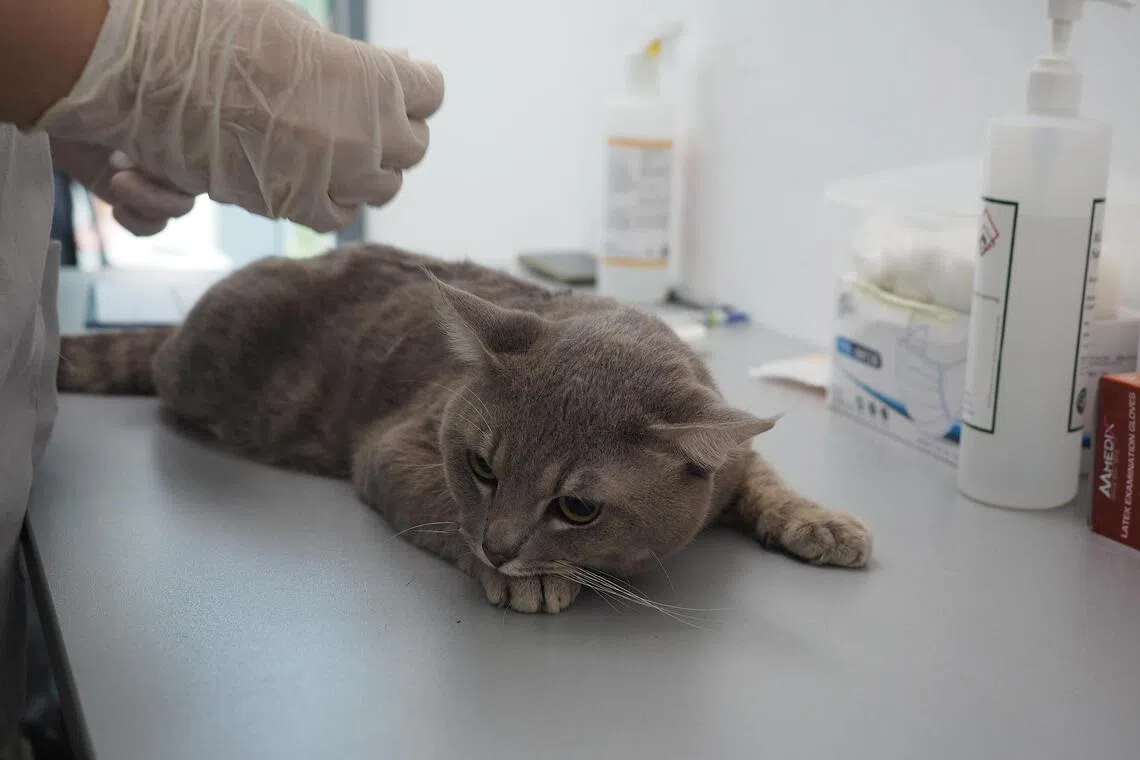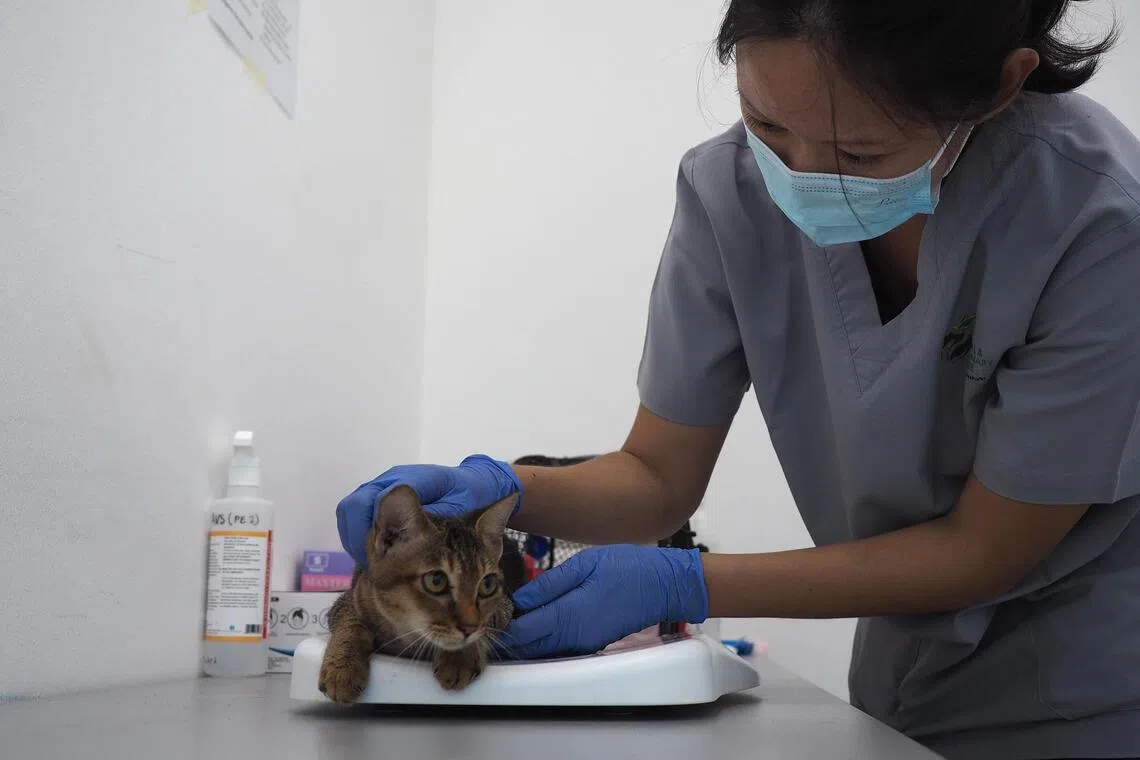Vet Talk: Six myths about sterilising your pet cat
Sign up now: Get ST's newsletters delivered to your inbox

Sterilised cats live longer, healthier lives with significantly reduced risk of several cancers.
PHOTO: PHOTO: ANIMAL & VETERINARY SERVICE
Lin Anhui
Follow topic:
- Sterilisation, recommended at four to six months, prevents unwanted litters, reduces cancer risks, and corrects the misconception that it causes weight gain.
- The Pet Cat Sterilisation Support (PCSS) programme offers free microchipping and sterilisation for lower-income households.
- Sterilised cats are healthier and happier, and owners can license them for free until Aug 2026.
AI generated
SINGAPORE – The Cat-ember 2025 celebration marks one year since the National Parks Board’s Animal & Veterinary Service (AVS) launched the Cat Management Framework
Organised by the statutory board, Cat-ember is a month-long event in September with community events, workshops and exhibitions to promote responsible pet ownership and harmonious living with cats.
The framework strives to improve the welfare and management of pet and community cats, while striking a balance between the differing views on the keeping of cats.
Under it, pet owners are allowed to keep up to two cats in an HDB flat, and up to three cats for each private residence, with owners required to license and microchip their cats by Aug 31, 2026.
Those with more cats than the stipulated limits are allowed to license and keep all their existing pet cats if they can ensure that the animals’ health and welfare are taken care of.
About 41,000 pet cats have since been licensed, with around 95 per cent sterilised.
Some owners, however, may still have reservations about sterilising their cats due to unfounded concerns or misunderstandings. Here are some myths.
Myth 1: My four-month-old kitten is just a baby and too young to breed
Cats can breed from four months old and produce up to four litters annually. Your “baby” could have had a litter of its own.
Based on AVS’ survey, some owners delay sterilisation because they deem their cats too young. A female cat will give birth about two months after becoming pregnant. An unsterilised pair can multiply very quickly and overwhelm your capacity for care.
Myth 2: My six-month-old kitten is too young to be sterilised
Sterilisation is recommended when cats are about four to six months old. The “Fix by Five” guideline to neuter cats before they reach five months old is endorsed by the World Small Animal Veterinary Association and the American Veterinary Medical Association. Younger cats are also likely to recover more quickly from surgery than older cats.
Myth 3: Sterilisation makes cats fat and lazy
Weight gain is typically due to overfeeding, a lack of exercise or underlying health issues, and not sterilisation.
Contrary to popular belief, sterilisation brings multiple behavioural benefits. Given their reduced desire to mate, sterilised cats are less likely to roam, caterwaul (howl loudly) and mark their territory with a pungent urine spray.
Sterilised male cats are less likely to fight, reducing the risk of cat bite infections and infectious diseases, such as feline immunodeficiency virus and feline leukaemia virus. Sterilised cats are calmer and easier to manage – your neighbours will thank you too.
Myth 4: Sterilisation has limited health benefits
Sterilised cats live longer, healthier lives with significantly reduced risk of several cancers.
Sterilisation of female cats before their first heat greatly reduces the risk of mammary, ovarian and uterine cancers.
It removes the reproductive organs (ovaries, uterus) at risk of cancer, as well as the source of reproductive hormones that drive mammary cancer. In fact, the earlier the sterilisation, the greater the reduction in cancer risk.

A 2005 study published in the Journal of Veterinary Internal Medicine found that cats spayed before six months of age had 91 per cent lower risk of mammary cancer.
PHOTO: ANIMAL & VETERINARY SERVICE
Mammary cancer is the third most common cancer in cats, with most mammary tumours being malignant and affected cats living less than a year on average.
A 2005 study published in the Journal of Veterinary Internal Medicine found that cats spayed before six months of age had 91 per cent lower risk of mammary cancer.
In females, sterilisation also prevents a potentially fatal infection of the uterus called pyometra. In male cats, sterilisation prevents testicular tumours and reduces the risk of prostate disease.
Myth 5: Sterilisation surgery is too risky
Sterilisation is a routine, commonly performed procedure which is generally considered safe. Thanks to advances in surgical techniques, anaesthetic drugs and patient care, surgical and anaesthetic risks are lower than before.
Most cats return to normal activity in a few days, with full healing of the surgical site typically within two weeks. Consult your veterinarian for a health assessment of your pet for sterilisation. Overall, the health and behavioural benefits of sterilisation far outweigh the risks.
Myth 6: There is no government assistance for pet cat sterilisation
The Pet Cat Sterilisation Support (PCSS) programme, launched in September 2024, provides free microchipping and sterilisation of pet cats in lower-income households. This is an early intervention measure to stem accidental breeding of pet cats within households and to address animal welfare and issues arising from overpopulation.
Eligible owners include financial assistance recipients (for example, those under Ministry of Social and Family Development and Community Development Council schemes), blue Chas cardholders and Public Rental Scheme residents. Cat owners can register for the PCSS programme at go.gov.sg/avs-pcss
The PCSS programme is supported by donations through NParks’ charity Garden City Fund. Donations are welcome through go.gov.sg/chipandsnip
Still hesitating?
Sterilised cats are happier and healthier. Be a responsible pet owner and sterilise your cat by six months of age to prevent unwanted litters, and bring health and behavioural benefits. In addition, licensing of sterilised pet cats is free till Aug 31, 2026, and is valid for a lifetime.
From Sept 1, 2026, new lifetime licences for sterilised cats cost $35. Unsterilised cats will have higher licensing fees upon renewal at $90 annually. For more information, go to the Cat Management Framework at go.gov.sg/cat-framework
Dr Lin Anhui is a veterinarian and the director of veterinary science programmes and community animal management operations at the AVS.
Vet Talk is a fortnightly column where veterinarians offer advice on pet issues.

